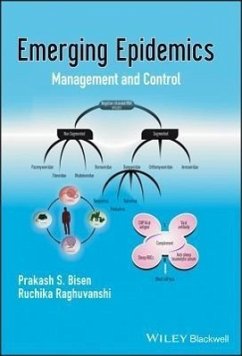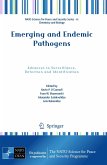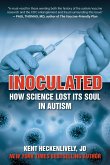- Gebundenes Buch
- Merkliste
- Auf die Merkliste
- Bewerten Bewerten
- Teilen
- Produkt teilen
- Produkterinnerung
- Produkterinnerung
A global perspective on the management and prevention of emerging and re-emerging diseases Emerging infectious diseases are newly identified or otherwise previously unknown infections that cause public health challenges. Re-emerging infectious diseases are due to both the reappearance of and an increase in the number of infections from a disease that is known, but which had formerly caused so few infections that it was no longer considered a public health problem. The factors that cause the emergence or re-emergence of a disease are diverse. This book takes a look at the world's emerging and…mehr
Andere Kunden interessierten sich auch für
![Emerging and Endemic Pathogens Emerging and Endemic Pathogens]() Emerging and Endemic Pathogens210,99 €
Emerging and Endemic Pathogens210,99 €![Emerging and Endemic Pathogens Emerging and Endemic Pathogens]() Emerging and Endemic Pathogens149,99 €
Emerging and Endemic Pathogens149,99 €![Molecular Virology and Control of Flaviviruses Molecular Virology and Control of Flaviviruses]() Molecular Virology and Control of Flaviviruses246,99 €
Molecular Virology and Control of Flaviviruses246,99 €![Inoculated Inoculated]() Kent HeckenlivelyInoculated19,99 €
Kent HeckenlivelyInoculated19,99 €![Orthopoxviruses Pathogenic for Humans Orthopoxviruses Pathogenic for Humans]() Orthopoxviruses Pathogenic for Humans112,99 €
Orthopoxviruses Pathogenic for Humans112,99 €![Theory of the Spread of Epidemics and Movement Ecology of Animals Theory of the Spread of Epidemics and Movement Ecology of Animals]() V M Kenkre (Nitant)Theory of the Spread of Epidemics and Movement Ecology of Animals164,99 €
V M Kenkre (Nitant)Theory of the Spread of Epidemics and Movement Ecology of Animals164,99 €![Twelve Diseases That Changed Our World Twelve Diseases That Changed Our World]() Irwin W. ShermanTwelve Diseases That Changed Our World29,99 €
Irwin W. ShermanTwelve Diseases That Changed Our World29,99 €-
-
-
A global perspective on the management and prevention of emerging and re-emerging diseases Emerging infectious diseases are newly identified or otherwise previously unknown infections that cause public health challenges. Re-emerging infectious diseases are due to both the reappearance of and an increase in the number of infections from a disease that is known, but which had formerly caused so few infections that it was no longer considered a public health problem. The factors that cause the emergence or re-emergence of a disease are diverse. This book takes a look at the world's emerging and re-emerging diseases. It covers the diagnosis, therapy, prevention, and control of a variety of individual diseases, and examines the social and behavioral issues that could contribute to epidemics. Each chapter focuses on an individual disease and provides scientific background and social history as well as the current basics of infection, epidemiology, and control. Emerging Epidemics: Management and Control offers five topics of coverage: FUNDAMENTALS * Epidemics fundamentals * Disasters and epidemics * Biosafety RE-EMERGING EPIDEMICS * Tuberculosis * Plague NEWLY EMERGING EPIDEMICS * Leptospirosis * Dengue * Japanese Encephalitis * Chikungunya Fever * West Nile Virus * Chandipura Virus Encephalitis * Kyasanur Forest Disease * Hantavirus * Human, Avian, and Swine Influenza * Severe Acute Respiratory Syndrome * Nipah Virus * Paragonimiasis * Melioidosis POTENTIAL EPIDEMICS * Biowarfare and bioterrorism * Food contamination and food terrorism * Antimicrobial resistance VECTOR CONTROL METHODS * Mosquito control * Other disease vectors and their control Offering an integrated, worldwide overview of the complexity of the epidemiology of infections, Emerging Epidemics will be a valuable resource for students, physicians, and scientists working in veterinary, medical, and the pharmaceutical sciences.
Produktdetails
- Produktdetails
- Verlag: Wiley
- Seitenzahl: 760
- Erscheinungstermin: 23. September 2013
- Englisch
- Abmessung: 246mm x 175mm x 36mm
- Gewicht: 1451g
- ISBN-13: 9781118393239
- ISBN-10: 1118393236
- Artikelnr.: 37314451
- Herstellerkennzeichnung
- Libri GmbH
- Europaallee 1
- 36244 Bad Hersfeld
- gpsr@libri.de
- Verlag: Wiley
- Seitenzahl: 760
- Erscheinungstermin: 23. September 2013
- Englisch
- Abmessung: 246mm x 175mm x 36mm
- Gewicht: 1451g
- ISBN-13: 9781118393239
- ISBN-10: 1118393236
- Artikelnr.: 37314451
- Herstellerkennzeichnung
- Libri GmbH
- Europaallee 1
- 36244 Bad Hersfeld
- gpsr@libri.de
Prakash Singh Bisen, PhD, D.Sc, is an eminent scientist in the field of Biotechnology with over 32 years of research and teaching experience. He has one US Patent and an Indian Patent on Tuberculosis to his credit. He is also an author of over 130 research publications. Presently, Professor Bisen is the Chairman of Bisen Biotech and Biopharma (P) Ltd. - a private equity venture which focuses on diagnostic solutions for widespread diseases. Professor Bisen is also the Chairman of the Vikrant Group, which focuses on advancing technical education through technical institutes at Gwalior and Indore, India. Ruchika Raghuvanshi, PhD, is a Research Scientist at the Defence Research Development Organization, a division of the Indian Ministry of Defence. Vijayaraghavan, PhD, is Director of the Defence Research Development Establishment, the Defence Research Development Organization, a division of the Indian Ministry of Defence.
Preface xv
Acknowledgments xvii
Chapter 1 Prologue 3
Introduction 3
Causative Factors 7
Salient Features 11
Emerging Epidemics 11
Re-Emerging Epidemics 17
Antimicrobial Resistance 18
Public Health Implications 20
References 22
Chapter 2 Epidemics Fundamentals 24
Introduction 24
Definitions 24
Types of Epidemics 26
Epidemiological Triad 29
Forecasting an Epidemic 31
Contingency Plan 33
Investigation of Epidemics 35
Management of Epidemics 38
Control of Epidemics 39
Principles of Planning Emergency Services 41
References 44
Chapter 3 Disasters and Epidemics 46
Fundamentals 46
Contributory Factors 51
Investigation of Rumors 52
References 54
Chapter 4 Biosafety 56
Introduction 56
Components 57
Hand Washing 61
Preventing Needlestick Injuries 62
Safe Transport of Biological Material 64
Safe Decontamination of Spills 65
Safe Handling of Dead Bodies 67
Personal Protective Equipment 69
Management of Biomedical Waste 69
Infection Control Check List 71
Biosafety Levels 71
Accreditation of Hospitals and Laboratories 74
References 75
Chapter 5 Tuberculosis 76
History 76
Magnitude 78
Agent Factors 81
Host Factors and High-Risk Groups 88
Environmental Factors 89
Modes of Transmission 90
Pathology and Immunology 91
Clinical Manifestations 96
Diagnosis of Tuberculosis 101
Directly Observed Treatment, Short Course (DOTS) 119
Tuberculosis and HIV 135
Drug-Resistant Tuberculosis 140
Prevention and Control 142
Social and Cultural Factors 145
References 148
Chapter 6 Plague 154
History of Plague 154
Magnitude 155
Agent Factors 157
Host Factors 158
Environmental Factors 159
Reservoir 159
Mode of Transmission 160
Clinical Manifestations 161
Laboratory Diagnosis 164
Differential Diagnosis 170
Clinical Management 170
Prevention and Control 172
References 174
Chapter 7 Leptospirosis 176
Introduction 176
Magnitude 176
Agent Factors 177
Host Factors 179
Environmental Factors 182
Mode of Transmission 183
Pathology and Immunology 183
Clinical Manifestations 185
Laboratory Diagnosis 189
Clinical Management 206
Surveillance 210
Investigation of an Outbreak 211
Prevention and Control 213
References 217
Chapter 8 Dengue 220
Introduction 220
Magnitude 221
Agent Factors 222
Host Factors 228
Environmental Factors 230
Vector Biology 231
Clinical Features 235
Laboratory Diagnosis 244
Immune Response to Dengue Virus 245
Clinical Management 248
Investigation of Outbreaks 253
Prevention and Control 257
References 259
Chapter 9 Japanese Encephalitis 263
History 263
Magnitude of the Problem 264
Epidemiology 266
Vector Biology 270
Clinical Features 270
Differential Diagnosis 271
Laboratory Diagnosis 272
Case Management 275
Prevention and Control 278
References 280
Chapter 10 Chikungunya Fever 283
Introduction 283
Epidemiology 284
The Chikungunya Virus 284
Clinical Features 291
Laboratory Diagnosis 298
Differential Diagnosis 300
Clinical Management 301
Investigation of Outbreaks 306
Treatment 307
Prevention and Control 308
References 311
Chapter 11 West Nile Fever 316
Epidemiology 316
Global Scenario 317
The Etiological Agent 318
Clinical Features 322
Laboratory Diagnosis 324
Clinical Management 326
Investigation of Outbreaks 327
Prevention and Control 330
References 336
Chapter 12 Chandipura Virus Encephalitis 340
Epidemiology 340
The Chandipura Virus 341
Clinical Features 350
Laboratory Diagnosis 351
Differential Diagnosis 353
Clinical Management 354
Investigation of Outbreaks 356
Prevention and Control 358
References 359
Chapter 13 Kyasanur Forest Disease 361
Introduction 361
Epidemiology 362
Vector Biology 363
Clinical Features 366
Differential Diagnosis 366
Laboratory Diagnosis 368
Case Management 369
Prevention and Control 371
References 374
Chapter 14 Hantavirus Disease 375
Introduction 375
Epidemiology and Global Scenario 376
The Etiological Agent 381
Clinical Features 387
Differential Diagnosis 390
Laboratory Diagnosis 390
Case Management 393
Prevention and Control 394
References 396
Chapter 15 Influenza 400
Historical Aspects 400
Global Scenario 402
Agent Factors 405
Host Factors 418
Environmental Factors 419
Mode of Transmission 421
Clinical Manifestations 422
Immune Response to Influenza 424
Laboratory Diagnosis 427
Clinical Management 431
Surveillance 434
Investigation of an Outbreak 437
Prevention and Control 441
Avian Influenza 445
Swine Influenza 447
References 450
Chapter 16 Severe Acute Respiratory Syndrome 455
Introduction 455
Epidemiology 455
Causative Agent 456
Transmission of Severe Acute Respiratory Syndrome Virus 456
Clinical Features 457
Laboratory Diagnosis 457
Treatment 458
Prevention and Control 461
References 461
Chapter 17 Nipah Virus 462
Introduction 462
Epidemiology 463
Etiological Agent 463
Transmission 463
Clinical Features 466
Laboratory Diagnosis 467
Prevention and Control 468
References 469
Chapter 18 Paragonimiasis 470
Magnitude of the Problem 470
The Parasite: Paragonimus 471
Epidemiology 475
Clinical Manifestations 478
Radiological Features of Paragonimiasis 481
Laboratory Diagnosis 484
Differential Diagnosis 487
Clinical Management 487
Public Health Importance 488
References 489
Chapter 19 Melioidosis 492
Introduction 492
Epidemiology 493
The Etiological Agent: Burkholderia pseudomallei 495
Clinical Manifestations 498
Laboratory Diagnosis 501
Clinical Management 503
Investigation of an Outbreak 504
Prevention and Control of Melioidosis 506
Public Health Importance 508
References 508
Chapter 20 Biowarfare and Bioterrorism 513
Introduction 513
Historical Aspects 514
Potential Agents 519
Epidemiological Clues 545
Laboratory Diagnosis 548
Clinical Management 566
Biosurveillance 568
Investigation of an Outbreak 573
Preparedness and Containment 576
References 578
Chapter 21 Antimicrobial Resistance 585
Introduction 585
Global Scenario 586
Drug-Resistant Organisms 588
Causes of Drug Resistance 593
Mechanisms of Drug Resistance 595
Host Factors 598
Health-Related and Economic Hazards 599
Laboratory Diagnosis 601
Managing Antimicrobial Resistance 607
Prevention and Control 610
References 612
Chapter 22 Conventional Methods for Mosquito Control 615
Mosquito: Habits and Attractants 615
Environmental Management 618
Antilarval Measures 623
Chemical Adulticides 627
Repellents 630
Insecticide-Impregnated Bed Nets and Screens 632
References 633
Chapter 23 New and Potential Techniques: Mosquito Control 635
Myco-Insecticides 635
Entomopathogenic Bacteria and Viruses 637
Hormonomimetic and Plant-Derived Substances 639
Larvivorous Fish and Crustaceans 640
Dragonfly Nymphs 643
Protozoa 643
Mermithid Nematodes 644
Predator Larvae 645
Genetic Engineering 646
References 648
Chapter 24 Other Disease Vectors and Their Control 651
Housefly 651
Sand Fly 653
Deer Fly 653
Black Fly 655
Tsetse Fly 655
Water Flea (Cyclops) 656
Sand Flea (Jigger or Chigoe Flea) 657
Rat Flea 658
Reduviid Bug 658
Ticks (Hard and Soft) 659
Lice 662
Cockroach 663
Mites (Chiggers) 664
General Principles of Vector Control 666
Integrated Vector Management 667
Rodents 670
Methods for Rodent Control 671
References 672
Glossary 674
Index 683
Acknowledgments xvii
Chapter 1 Prologue 3
Introduction 3
Causative Factors 7
Salient Features 11
Emerging Epidemics 11
Re-Emerging Epidemics 17
Antimicrobial Resistance 18
Public Health Implications 20
References 22
Chapter 2 Epidemics Fundamentals 24
Introduction 24
Definitions 24
Types of Epidemics 26
Epidemiological Triad 29
Forecasting an Epidemic 31
Contingency Plan 33
Investigation of Epidemics 35
Management of Epidemics 38
Control of Epidemics 39
Principles of Planning Emergency Services 41
References 44
Chapter 3 Disasters and Epidemics 46
Fundamentals 46
Contributory Factors 51
Investigation of Rumors 52
References 54
Chapter 4 Biosafety 56
Introduction 56
Components 57
Hand Washing 61
Preventing Needlestick Injuries 62
Safe Transport of Biological Material 64
Safe Decontamination of Spills 65
Safe Handling of Dead Bodies 67
Personal Protective Equipment 69
Management of Biomedical Waste 69
Infection Control Check List 71
Biosafety Levels 71
Accreditation of Hospitals and Laboratories 74
References 75
Chapter 5 Tuberculosis 76
History 76
Magnitude 78
Agent Factors 81
Host Factors and High-Risk Groups 88
Environmental Factors 89
Modes of Transmission 90
Pathology and Immunology 91
Clinical Manifestations 96
Diagnosis of Tuberculosis 101
Directly Observed Treatment, Short Course (DOTS) 119
Tuberculosis and HIV 135
Drug-Resistant Tuberculosis 140
Prevention and Control 142
Social and Cultural Factors 145
References 148
Chapter 6 Plague 154
History of Plague 154
Magnitude 155
Agent Factors 157
Host Factors 158
Environmental Factors 159
Reservoir 159
Mode of Transmission 160
Clinical Manifestations 161
Laboratory Diagnosis 164
Differential Diagnosis 170
Clinical Management 170
Prevention and Control 172
References 174
Chapter 7 Leptospirosis 176
Introduction 176
Magnitude 176
Agent Factors 177
Host Factors 179
Environmental Factors 182
Mode of Transmission 183
Pathology and Immunology 183
Clinical Manifestations 185
Laboratory Diagnosis 189
Clinical Management 206
Surveillance 210
Investigation of an Outbreak 211
Prevention and Control 213
References 217
Chapter 8 Dengue 220
Introduction 220
Magnitude 221
Agent Factors 222
Host Factors 228
Environmental Factors 230
Vector Biology 231
Clinical Features 235
Laboratory Diagnosis 244
Immune Response to Dengue Virus 245
Clinical Management 248
Investigation of Outbreaks 253
Prevention and Control 257
References 259
Chapter 9 Japanese Encephalitis 263
History 263
Magnitude of the Problem 264
Epidemiology 266
Vector Biology 270
Clinical Features 270
Differential Diagnosis 271
Laboratory Diagnosis 272
Case Management 275
Prevention and Control 278
References 280
Chapter 10 Chikungunya Fever 283
Introduction 283
Epidemiology 284
The Chikungunya Virus 284
Clinical Features 291
Laboratory Diagnosis 298
Differential Diagnosis 300
Clinical Management 301
Investigation of Outbreaks 306
Treatment 307
Prevention and Control 308
References 311
Chapter 11 West Nile Fever 316
Epidemiology 316
Global Scenario 317
The Etiological Agent 318
Clinical Features 322
Laboratory Diagnosis 324
Clinical Management 326
Investigation of Outbreaks 327
Prevention and Control 330
References 336
Chapter 12 Chandipura Virus Encephalitis 340
Epidemiology 340
The Chandipura Virus 341
Clinical Features 350
Laboratory Diagnosis 351
Differential Diagnosis 353
Clinical Management 354
Investigation of Outbreaks 356
Prevention and Control 358
References 359
Chapter 13 Kyasanur Forest Disease 361
Introduction 361
Epidemiology 362
Vector Biology 363
Clinical Features 366
Differential Diagnosis 366
Laboratory Diagnosis 368
Case Management 369
Prevention and Control 371
References 374
Chapter 14 Hantavirus Disease 375
Introduction 375
Epidemiology and Global Scenario 376
The Etiological Agent 381
Clinical Features 387
Differential Diagnosis 390
Laboratory Diagnosis 390
Case Management 393
Prevention and Control 394
References 396
Chapter 15 Influenza 400
Historical Aspects 400
Global Scenario 402
Agent Factors 405
Host Factors 418
Environmental Factors 419
Mode of Transmission 421
Clinical Manifestations 422
Immune Response to Influenza 424
Laboratory Diagnosis 427
Clinical Management 431
Surveillance 434
Investigation of an Outbreak 437
Prevention and Control 441
Avian Influenza 445
Swine Influenza 447
References 450
Chapter 16 Severe Acute Respiratory Syndrome 455
Introduction 455
Epidemiology 455
Causative Agent 456
Transmission of Severe Acute Respiratory Syndrome Virus 456
Clinical Features 457
Laboratory Diagnosis 457
Treatment 458
Prevention and Control 461
References 461
Chapter 17 Nipah Virus 462
Introduction 462
Epidemiology 463
Etiological Agent 463
Transmission 463
Clinical Features 466
Laboratory Diagnosis 467
Prevention and Control 468
References 469
Chapter 18 Paragonimiasis 470
Magnitude of the Problem 470
The Parasite: Paragonimus 471
Epidemiology 475
Clinical Manifestations 478
Radiological Features of Paragonimiasis 481
Laboratory Diagnosis 484
Differential Diagnosis 487
Clinical Management 487
Public Health Importance 488
References 489
Chapter 19 Melioidosis 492
Introduction 492
Epidemiology 493
The Etiological Agent: Burkholderia pseudomallei 495
Clinical Manifestations 498
Laboratory Diagnosis 501
Clinical Management 503
Investigation of an Outbreak 504
Prevention and Control of Melioidosis 506
Public Health Importance 508
References 508
Chapter 20 Biowarfare and Bioterrorism 513
Introduction 513
Historical Aspects 514
Potential Agents 519
Epidemiological Clues 545
Laboratory Diagnosis 548
Clinical Management 566
Biosurveillance 568
Investigation of an Outbreak 573
Preparedness and Containment 576
References 578
Chapter 21 Antimicrobial Resistance 585
Introduction 585
Global Scenario 586
Drug-Resistant Organisms 588
Causes of Drug Resistance 593
Mechanisms of Drug Resistance 595
Host Factors 598
Health-Related and Economic Hazards 599
Laboratory Diagnosis 601
Managing Antimicrobial Resistance 607
Prevention and Control 610
References 612
Chapter 22 Conventional Methods for Mosquito Control 615
Mosquito: Habits and Attractants 615
Environmental Management 618
Antilarval Measures 623
Chemical Adulticides 627
Repellents 630
Insecticide-Impregnated Bed Nets and Screens 632
References 633
Chapter 23 New and Potential Techniques: Mosquito Control 635
Myco-Insecticides 635
Entomopathogenic Bacteria and Viruses 637
Hormonomimetic and Plant-Derived Substances 639
Larvivorous Fish and Crustaceans 640
Dragonfly Nymphs 643
Protozoa 643
Mermithid Nematodes 644
Predator Larvae 645
Genetic Engineering 646
References 648
Chapter 24 Other Disease Vectors and Their Control 651
Housefly 651
Sand Fly 653
Deer Fly 653
Black Fly 655
Tsetse Fly 655
Water Flea (Cyclops) 656
Sand Flea (Jigger or Chigoe Flea) 657
Rat Flea 658
Reduviid Bug 658
Ticks (Hard and Soft) 659
Lice 662
Cockroach 663
Mites (Chiggers) 664
General Principles of Vector Control 666
Integrated Vector Management 667
Rodents 670
Methods for Rodent Control 671
References 672
Glossary 674
Index 683
Preface xv
Acknowledgments xvii
Chapter 1 Prologue 3
Introduction 3
Causative Factors 7
Salient Features 11
Emerging Epidemics 11
Re-Emerging Epidemics 17
Antimicrobial Resistance 18
Public Health Implications 20
References 22
Chapter 2 Epidemics Fundamentals 24
Introduction 24
Definitions 24
Types of Epidemics 26
Epidemiological Triad 29
Forecasting an Epidemic 31
Contingency Plan 33
Investigation of Epidemics 35
Management of Epidemics 38
Control of Epidemics 39
Principles of Planning Emergency Services 41
References 44
Chapter 3 Disasters and Epidemics 46
Fundamentals 46
Contributory Factors 51
Investigation of Rumors 52
References 54
Chapter 4 Biosafety 56
Introduction 56
Components 57
Hand Washing 61
Preventing Needlestick Injuries 62
Safe Transport of Biological Material 64
Safe Decontamination of Spills 65
Safe Handling of Dead Bodies 67
Personal Protective Equipment 69
Management of Biomedical Waste 69
Infection Control Check List 71
Biosafety Levels 71
Accreditation of Hospitals and Laboratories 74
References 75
Chapter 5 Tuberculosis 76
History 76
Magnitude 78
Agent Factors 81
Host Factors and High-Risk Groups 88
Environmental Factors 89
Modes of Transmission 90
Pathology and Immunology 91
Clinical Manifestations 96
Diagnosis of Tuberculosis 101
Directly Observed Treatment, Short Course (DOTS) 119
Tuberculosis and HIV 135
Drug-Resistant Tuberculosis 140
Prevention and Control 142
Social and Cultural Factors 145
References 148
Chapter 6 Plague 154
History of Plague 154
Magnitude 155
Agent Factors 157
Host Factors 158
Environmental Factors 159
Reservoir 159
Mode of Transmission 160
Clinical Manifestations 161
Laboratory Diagnosis 164
Differential Diagnosis 170
Clinical Management 170
Prevention and Control 172
References 174
Chapter 7 Leptospirosis 176
Introduction 176
Magnitude 176
Agent Factors 177
Host Factors 179
Environmental Factors 182
Mode of Transmission 183
Pathology and Immunology 183
Clinical Manifestations 185
Laboratory Diagnosis 189
Clinical Management 206
Surveillance 210
Investigation of an Outbreak 211
Prevention and Control 213
References 217
Chapter 8 Dengue 220
Introduction 220
Magnitude 221
Agent Factors 222
Host Factors 228
Environmental Factors 230
Vector Biology 231
Clinical Features 235
Laboratory Diagnosis 244
Immune Response to Dengue Virus 245
Clinical Management 248
Investigation of Outbreaks 253
Prevention and Control 257
References 259
Chapter 9 Japanese Encephalitis 263
History 263
Magnitude of the Problem 264
Epidemiology 266
Vector Biology 270
Clinical Features 270
Differential Diagnosis 271
Laboratory Diagnosis 272
Case Management 275
Prevention and Control 278
References 280
Chapter 10 Chikungunya Fever 283
Introduction 283
Epidemiology 284
The Chikungunya Virus 284
Clinical Features 291
Laboratory Diagnosis 298
Differential Diagnosis 300
Clinical Management 301
Investigation of Outbreaks 306
Treatment 307
Prevention and Control 308
References 311
Chapter 11 West Nile Fever 316
Epidemiology 316
Global Scenario 317
The Etiological Agent 318
Clinical Features 322
Laboratory Diagnosis 324
Clinical Management 326
Investigation of Outbreaks 327
Prevention and Control 330
References 336
Chapter 12 Chandipura Virus Encephalitis 340
Epidemiology 340
The Chandipura Virus 341
Clinical Features 350
Laboratory Diagnosis 351
Differential Diagnosis 353
Clinical Management 354
Investigation of Outbreaks 356
Prevention and Control 358
References 359
Chapter 13 Kyasanur Forest Disease 361
Introduction 361
Epidemiology 362
Vector Biology 363
Clinical Features 366
Differential Diagnosis 366
Laboratory Diagnosis 368
Case Management 369
Prevention and Control 371
References 374
Chapter 14 Hantavirus Disease 375
Introduction 375
Epidemiology and Global Scenario 376
The Etiological Agent 381
Clinical Features 387
Differential Diagnosis 390
Laboratory Diagnosis 390
Case Management 393
Prevention and Control 394
References 396
Chapter 15 Influenza 400
Historical Aspects 400
Global Scenario 402
Agent Factors 405
Host Factors 418
Environmental Factors 419
Mode of Transmission 421
Clinical Manifestations 422
Immune Response to Influenza 424
Laboratory Diagnosis 427
Clinical Management 431
Surveillance 434
Investigation of an Outbreak 437
Prevention and Control 441
Avian Influenza 445
Swine Influenza 447
References 450
Chapter 16 Severe Acute Respiratory Syndrome 455
Introduction 455
Epidemiology 455
Causative Agent 456
Transmission of Severe Acute Respiratory Syndrome Virus 456
Clinical Features 457
Laboratory Diagnosis 457
Treatment 458
Prevention and Control 461
References 461
Chapter 17 Nipah Virus 462
Introduction 462
Epidemiology 463
Etiological Agent 463
Transmission 463
Clinical Features 466
Laboratory Diagnosis 467
Prevention and Control 468
References 469
Chapter 18 Paragonimiasis 470
Magnitude of the Problem 470
The Parasite: Paragonimus 471
Epidemiology 475
Clinical Manifestations 478
Radiological Features of Paragonimiasis 481
Laboratory Diagnosis 484
Differential Diagnosis 487
Clinical Management 487
Public Health Importance 488
References 489
Chapter 19 Melioidosis 492
Introduction 492
Epidemiology 493
The Etiological Agent: Burkholderia pseudomallei 495
Clinical Manifestations 498
Laboratory Diagnosis 501
Clinical Management 503
Investigation of an Outbreak 504
Prevention and Control of Melioidosis 506
Public Health Importance 508
References 508
Chapter 20 Biowarfare and Bioterrorism 513
Introduction 513
Historical Aspects 514
Potential Agents 519
Epidemiological Clues 545
Laboratory Diagnosis 548
Clinical Management 566
Biosurveillance 568
Investigation of an Outbreak 573
Preparedness and Containment 576
References 578
Chapter 21 Antimicrobial Resistance 585
Introduction 585
Global Scenario 586
Drug-Resistant Organisms 588
Causes of Drug Resistance 593
Mechanisms of Drug Resistance 595
Host Factors 598
Health-Related and Economic Hazards 599
Laboratory Diagnosis 601
Managing Antimicrobial Resistance 607
Prevention and Control 610
References 612
Chapter 22 Conventional Methods for Mosquito Control 615
Mosquito: Habits and Attractants 615
Environmental Management 618
Antilarval Measures 623
Chemical Adulticides 627
Repellents 630
Insecticide-Impregnated Bed Nets and Screens 632
References 633
Chapter 23 New and Potential Techniques: Mosquito Control 635
Myco-Insecticides 635
Entomopathogenic Bacteria and Viruses 637
Hormonomimetic and Plant-Derived Substances 639
Larvivorous Fish and Crustaceans 640
Dragonfly Nymphs 643
Protozoa 643
Mermithid Nematodes 644
Predator Larvae 645
Genetic Engineering 646
References 648
Chapter 24 Other Disease Vectors and Their Control 651
Housefly 651
Sand Fly 653
Deer Fly 653
Black Fly 655
Tsetse Fly 655
Water Flea (Cyclops) 656
Sand Flea (Jigger or Chigoe Flea) 657
Rat Flea 658
Reduviid Bug 658
Ticks (Hard and Soft) 659
Lice 662
Cockroach 663
Mites (Chiggers) 664
General Principles of Vector Control 666
Integrated Vector Management 667
Rodents 670
Methods for Rodent Control 671
References 672
Glossary 674
Index 683
Acknowledgments xvii
Chapter 1 Prologue 3
Introduction 3
Causative Factors 7
Salient Features 11
Emerging Epidemics 11
Re-Emerging Epidemics 17
Antimicrobial Resistance 18
Public Health Implications 20
References 22
Chapter 2 Epidemics Fundamentals 24
Introduction 24
Definitions 24
Types of Epidemics 26
Epidemiological Triad 29
Forecasting an Epidemic 31
Contingency Plan 33
Investigation of Epidemics 35
Management of Epidemics 38
Control of Epidemics 39
Principles of Planning Emergency Services 41
References 44
Chapter 3 Disasters and Epidemics 46
Fundamentals 46
Contributory Factors 51
Investigation of Rumors 52
References 54
Chapter 4 Biosafety 56
Introduction 56
Components 57
Hand Washing 61
Preventing Needlestick Injuries 62
Safe Transport of Biological Material 64
Safe Decontamination of Spills 65
Safe Handling of Dead Bodies 67
Personal Protective Equipment 69
Management of Biomedical Waste 69
Infection Control Check List 71
Biosafety Levels 71
Accreditation of Hospitals and Laboratories 74
References 75
Chapter 5 Tuberculosis 76
History 76
Magnitude 78
Agent Factors 81
Host Factors and High-Risk Groups 88
Environmental Factors 89
Modes of Transmission 90
Pathology and Immunology 91
Clinical Manifestations 96
Diagnosis of Tuberculosis 101
Directly Observed Treatment, Short Course (DOTS) 119
Tuberculosis and HIV 135
Drug-Resistant Tuberculosis 140
Prevention and Control 142
Social and Cultural Factors 145
References 148
Chapter 6 Plague 154
History of Plague 154
Magnitude 155
Agent Factors 157
Host Factors 158
Environmental Factors 159
Reservoir 159
Mode of Transmission 160
Clinical Manifestations 161
Laboratory Diagnosis 164
Differential Diagnosis 170
Clinical Management 170
Prevention and Control 172
References 174
Chapter 7 Leptospirosis 176
Introduction 176
Magnitude 176
Agent Factors 177
Host Factors 179
Environmental Factors 182
Mode of Transmission 183
Pathology and Immunology 183
Clinical Manifestations 185
Laboratory Diagnosis 189
Clinical Management 206
Surveillance 210
Investigation of an Outbreak 211
Prevention and Control 213
References 217
Chapter 8 Dengue 220
Introduction 220
Magnitude 221
Agent Factors 222
Host Factors 228
Environmental Factors 230
Vector Biology 231
Clinical Features 235
Laboratory Diagnosis 244
Immune Response to Dengue Virus 245
Clinical Management 248
Investigation of Outbreaks 253
Prevention and Control 257
References 259
Chapter 9 Japanese Encephalitis 263
History 263
Magnitude of the Problem 264
Epidemiology 266
Vector Biology 270
Clinical Features 270
Differential Diagnosis 271
Laboratory Diagnosis 272
Case Management 275
Prevention and Control 278
References 280
Chapter 10 Chikungunya Fever 283
Introduction 283
Epidemiology 284
The Chikungunya Virus 284
Clinical Features 291
Laboratory Diagnosis 298
Differential Diagnosis 300
Clinical Management 301
Investigation of Outbreaks 306
Treatment 307
Prevention and Control 308
References 311
Chapter 11 West Nile Fever 316
Epidemiology 316
Global Scenario 317
The Etiological Agent 318
Clinical Features 322
Laboratory Diagnosis 324
Clinical Management 326
Investigation of Outbreaks 327
Prevention and Control 330
References 336
Chapter 12 Chandipura Virus Encephalitis 340
Epidemiology 340
The Chandipura Virus 341
Clinical Features 350
Laboratory Diagnosis 351
Differential Diagnosis 353
Clinical Management 354
Investigation of Outbreaks 356
Prevention and Control 358
References 359
Chapter 13 Kyasanur Forest Disease 361
Introduction 361
Epidemiology 362
Vector Biology 363
Clinical Features 366
Differential Diagnosis 366
Laboratory Diagnosis 368
Case Management 369
Prevention and Control 371
References 374
Chapter 14 Hantavirus Disease 375
Introduction 375
Epidemiology and Global Scenario 376
The Etiological Agent 381
Clinical Features 387
Differential Diagnosis 390
Laboratory Diagnosis 390
Case Management 393
Prevention and Control 394
References 396
Chapter 15 Influenza 400
Historical Aspects 400
Global Scenario 402
Agent Factors 405
Host Factors 418
Environmental Factors 419
Mode of Transmission 421
Clinical Manifestations 422
Immune Response to Influenza 424
Laboratory Diagnosis 427
Clinical Management 431
Surveillance 434
Investigation of an Outbreak 437
Prevention and Control 441
Avian Influenza 445
Swine Influenza 447
References 450
Chapter 16 Severe Acute Respiratory Syndrome 455
Introduction 455
Epidemiology 455
Causative Agent 456
Transmission of Severe Acute Respiratory Syndrome Virus 456
Clinical Features 457
Laboratory Diagnosis 457
Treatment 458
Prevention and Control 461
References 461
Chapter 17 Nipah Virus 462
Introduction 462
Epidemiology 463
Etiological Agent 463
Transmission 463
Clinical Features 466
Laboratory Diagnosis 467
Prevention and Control 468
References 469
Chapter 18 Paragonimiasis 470
Magnitude of the Problem 470
The Parasite: Paragonimus 471
Epidemiology 475
Clinical Manifestations 478
Radiological Features of Paragonimiasis 481
Laboratory Diagnosis 484
Differential Diagnosis 487
Clinical Management 487
Public Health Importance 488
References 489
Chapter 19 Melioidosis 492
Introduction 492
Epidemiology 493
The Etiological Agent: Burkholderia pseudomallei 495
Clinical Manifestations 498
Laboratory Diagnosis 501
Clinical Management 503
Investigation of an Outbreak 504
Prevention and Control of Melioidosis 506
Public Health Importance 508
References 508
Chapter 20 Biowarfare and Bioterrorism 513
Introduction 513
Historical Aspects 514
Potential Agents 519
Epidemiological Clues 545
Laboratory Diagnosis 548
Clinical Management 566
Biosurveillance 568
Investigation of an Outbreak 573
Preparedness and Containment 576
References 578
Chapter 21 Antimicrobial Resistance 585
Introduction 585
Global Scenario 586
Drug-Resistant Organisms 588
Causes of Drug Resistance 593
Mechanisms of Drug Resistance 595
Host Factors 598
Health-Related and Economic Hazards 599
Laboratory Diagnosis 601
Managing Antimicrobial Resistance 607
Prevention and Control 610
References 612
Chapter 22 Conventional Methods for Mosquito Control 615
Mosquito: Habits and Attractants 615
Environmental Management 618
Antilarval Measures 623
Chemical Adulticides 627
Repellents 630
Insecticide-Impregnated Bed Nets and Screens 632
References 633
Chapter 23 New and Potential Techniques: Mosquito Control 635
Myco-Insecticides 635
Entomopathogenic Bacteria and Viruses 637
Hormonomimetic and Plant-Derived Substances 639
Larvivorous Fish and Crustaceans 640
Dragonfly Nymphs 643
Protozoa 643
Mermithid Nematodes 644
Predator Larvae 645
Genetic Engineering 646
References 648
Chapter 24 Other Disease Vectors and Their Control 651
Housefly 651
Sand Fly 653
Deer Fly 653
Black Fly 655
Tsetse Fly 655
Water Flea (Cyclops) 656
Sand Flea (Jigger or Chigoe Flea) 657
Rat Flea 658
Reduviid Bug 658
Ticks (Hard and Soft) 659
Lice 662
Cockroach 663
Mites (Chiggers) 664
General Principles of Vector Control 666
Integrated Vector Management 667
Rodents 670
Methods for Rodent Control 671
References 672
Glossary 674
Index 683








